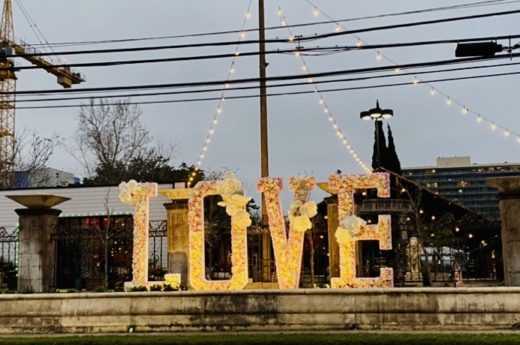Love and relationships a mini series - love defined
what is love?
That’s like asking what colour the rainbow is – there are many flavours that make up what we usually consider one monolithic concept.
The English language is not precise; each word can have multiple meanings, and while this is great for poets who use ambiguity to create messages designed to be interpreted multiple ways, it’s not helpful when trying to understand certain concepts like love.
Love has been sung about, talked about, written about, and fought about.
Yet, most of us still don’t have a good understanding of what it means when we hear it.
This is because one word can be used in so many different ways; before we can extract the meaning being applied at the time of use, we must first understand the context.
Ancient cultures were more specific when describing love; they used at least nine words to describe the different kinds of love.
According to these descriptions, each kind of love will lead to a specific outcome.
For example, let’s take Ludus. Ludus is defined as “sport or play – a game”, and was considered something children or young lovers engaged in. It’s fair to presume that a relationship based solely on Ludus would not survive tough times as Ludus, by definition, leads only to more fun. Two people that only have fun together aren’t preparing themselves to handle the ups and downs of life as a couple.
We fail in relationships because we don’t understand the definitions of love (what we’re doing), where each kind of love will lead us (where we’re going), the order in which to engage in each kind of love (correct timing), and the specific skills we must develop for each kind of love (how to do it correctly).
Our goal throughout this mini-series will be to develop a framework or model for thinking about love so that we can analyze any situation and accurately predict the probability of success before investing more time in a relationship.
The result will make it clear what people must do to make their current relationships work.
Let’s begin with the definitions of love – abridged for this article.
Love Defined
- Unconditional (Agape)
Caring regardless of the circumstances; caring whether you want to care or not, and whether the love is deserved or not; unselfish; dutiful; altruistic; “gift love” without ulterior motives and with no strings attached. - Friendship (Philia)
The strong bond existing between two people who share common interest or activity (friendships of delight), or character (friendships of the good). Friendship based on similar character is the highest level of friendship.
- Pragmatism (Pragma) Emphasizes compatibility and common sense; founded on reason or duty and one’s longer-term interests; emphasizes personal qualities, shared goals, compatibilities, and making it work.
- Self-Love (Philautia)
Love of self; regard for one’s own happiness or advantage.
- Affection (Storge)
Fondness through familiarity; affection and compassion; a gentle feeling of fondness or liking.
- Romance (Eros)
Sentimental or idealized love; fascination with ideal images of beauty; a feeling of excitement and mystery associated with love; the sense of being in love; passionate or romantic love.
- Physical Attraction (Venus)
Raw sexuality; physical desire; sexual love and sexual desire.
- Obsessiveness (Mania)
Obsessive; jealous; apparently irrational. Excessive enthusiasm or desire.
- Playfulness (Ludus)
A love that would rather be playful than serious; undemanding and uncommitted; love as a fun game.
Once I compiled these definitions of love, I spoke with a variety of people to understand how they formed romantic relationships (even arranged marriages). I also had multiple conversations with my friend Myka to clarify my thoughts on the optimal order for expressing different kinds of love.
Admittedly, this is a work in progress; the model doesn’t include Mania or Ludus because I’ve yet to fully understand how they fit into any model for developing a healthy long-term commitment to one person.
The color wheel theory of love says that “Manic lovers value finding partners through chance without prior knowledge of financial, educational, or personality dispositions.” This kind of decision making is reckless from a pragmatic point of view. It also highlights a general theme in many relationships: many people pledge their lives to each other (unconditional love) even though one or both persons don’t have the knowledge or ability (pragmatism) to keep their promises.
Given the following model, we aim to understand why such commitments might be made when with this information we can easily see why such relationships would be set up to fail.
The model is a simple linear progression from one stage of love to the other. Each stage builds on the previous stages in a way similar to Maslow’s hierarchy of needs. That is to say, you keep doing the things in the previous stages even after you’ve moved on to the next stage.
Steps to achieve long lasting love
Based on my research and analysis, the following is the suggested order for achieving and sustaining success in loving relationships.
Self Love > Pragmatism > Affection > Friendship > Romance > Unconditional > Physical Attraction
(1) Self Love
If you don’t love yourself, you don’t have the skills needed to be successful in relationships. This doesn’t mean you can’t form loving relationships, but it does mean that those relationships will contain seeds of self-destruction that will grow over time if left unchecked. Don’t look for someone else to love you out of a lack of self-love; learn to love yourself before you complicate your life by connecting with another flawed person who can’t possibly give you the love you can only give yourself.
(2) Pragmatism
The best time to decide if you want a person in your life is before you’re emotionally attached. Emotions often blind us to faults a person has – faults that will prevent the relationship from being successful over time. Pragmatic love recognizes that personal qualities, shared values, similar goals, similarity of experiences, and other compatibilities are key determinants of long-term relationship success. Opposites may attract, but they don’t succeed in marriage over the long-haul without a lot of unnecessary pain along the way. Pragmatism forces you to be honest about who you are, who the other person is, and whether or not the two of you are a good match. It uses time as an ally to uncover hidden truths about the people who want entrance into our lives. Unemotional decision making is exactly what’s needed at this stage. Use sensible rules to filter out incompatible people before (or soon after) you meet them.
Incidentally, this is where arranged marriages often provide superior results to the western model of individual choice. At its core, arranged marriage involves multiple family members of several generations in the decision-making process. A friend of mine from India simply put it like this: “they know you; they know her family; they know you both grew up the same way.” This lends credence to the assumption that similarity of experience is a good indicator of long-term compatibility. And even though you marry a stranger your similarities make it easier to become friends over time and grow into love. As one eastern proverb says: “Western love starts off like a raging fire which can only die down from there; eastern love starts off like a burning candle which grows into a raging fire over time.” Pragmatic love helps westerners simulate key parts of the process eastern families go through under a radically different system of matchmaking.
(3) Affection
Connecting with other people on a regular basis through discussion and shared activity creates familiarity. There will be some people you like (likes), and others you’ll want to avoid (dislikes). We can further divide the likes group into those who may become friends (likes-compatible), and those who you should still avoid due to character or lifestyle differences (likes-incompatible). At this stage of seeking love you may like someone but there’s no strong emotional bond. Associate with likes-compatible people; they’re your potential friends.
(4) Friendship
An ancient religious text asks the question: “Can two walk together unless they agree?” It’s a rhetorical question that gets to the heart of friendship – friends agree. The closer the friend, the more your values, habits, and interests align. People who marry often talk of marrying their best friend, and this is as it should be. Your best friend will emerge from your inner circle of close friends – they’ll have proven over time to be your closest friend because of the special mental, emotional, and behavioral bonds you’ve developed by spending time together in mutually satisfying interactions. Along the way you’ll have sacrificed for each other, helped, defended, laughed, cried, and stood beside each other during the good and bad times. A good friendship takes quality time to develop, and when looking back you should objectively see how enriched your life is because of this person. Unless a potential mate has reached this level of closeness it’s probably a mistake to consider them for the next stage – romance. Don’t consider this person a potential mate unless they meet the criteria of a close friend.
(5) Romance
One function of romance is to signal sexual interest without actually having sex (reminiscent of Victorian era courtship under the watchful eye of a chaperone). In its purest form romance is concerned with the heightened emotional atmosphere caused by the feeling of being in love. It’s the sense of being in love, and the passion that results from that high. This passion is partly designed to demonstrate how fulfilling sexual love could be with this person. Should this demonstration prove inadequate you can safely move back into friendship since no sexual intercourse has taken place. The other more important function of romance is to prepare you to move to the next stage, unconditional love.
Think about it.
By this stage both people love themselves (1), make sense as a couple according to pragmatic measures of long-term marital success (2), enjoy each other’s company (3), have a deep friendship that’s been tested over time (4) and are physically and emotionally attracted to each other (5).
At this point there’s nothing left to do but cool down emotionally (go back to stage 4) or make things permanent (move on to stage 6).
(6) Unconditional
This love, the highest form of love, is a permanent commitment to another person no matter what happens along the way. ‘Till death do us part isn’t a feeling; it’s a decision. You’re willing to unify your hopes, dreams, and life interests with this person. You’re willing to sacrifice almost everything to make this person happier (remember: they’re already happy because they love themselves) and this person is willing to do the same for you. You trust each other to keep promises because pragmatic analysis (stage 2) proved they possess the emotional, relational, and practical skills needed to be dependable providers, parents, friends, and lovers. With unconditional love you pragmatically analyze each other again – only in a deeper way. You thoroughly asses their character and their motives, considering the implications of all their words and deeds. Only when time and investigation convince you they are capable of keeping their promises do you agree to permanently tie your future happiness to this person (i.e. marriage).
(7) Physical
Sexual expression should be the crowning act in a long preparation process, a process that safeguards your heart by saving your greatest gift for the one person who has proven themselves worthy to be your permanent partner for everything this life has to offer. Many people may have a hard time agreeing with the previous sentence. But if they’re honest, they might admit to being occasionally haunted by the memory of a past lover who will never again be a part of their life. Why give anyone other than an unconditionally committed partner that kind of power over your heart? Another reason to wait is that sex clouds your judgment; think rose coloured glasses. Being in this state makes it harder for you to tear yourself away from a person who fails the pragmatic love test (stage 2). Pre-commitment sex (before stage 6) usually prevents you from developing a close friendship because the bond you feel conflates true emotional, behavioral, and mental oneness with emotional bonding that occurs naturally after sex. Protect your heart by waiting to unify your body with a person who has already unified themselves with you in every other possible way.
CONCLUSION
Now that we’ve defined the various kinds of love, we can use these definitions to analyze different scenarios. We’re now free to dig deeper into specific kinds of love to explore what each one has to offer. We’ll be doing just that in future articles within this series.
–Mark

Sign-up to our Community
Enjoy following my travel adventures and want to be notified when new blogs are posted? Complete the form below & subscribe to our mailing list where you can receive regular blog notifications, insights & information about featured products, events and other things Loved by Lina!



